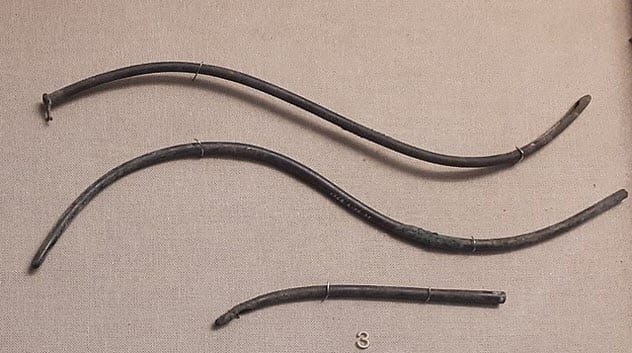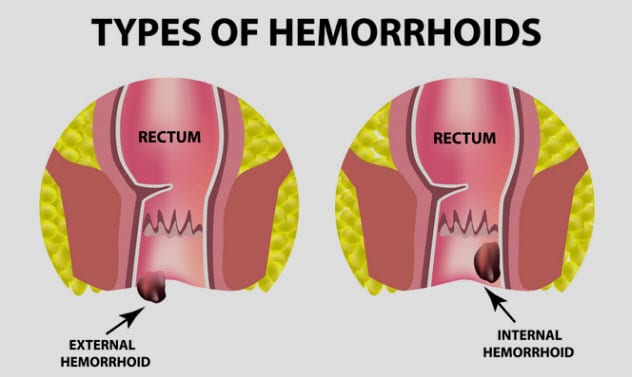 Weird Stuff
Weird Stuff  Weird Stuff
Weird Stuff  History
History 10 Legends Whose Last Moments Undid Their Glory
 Health
Health 10 Futuristic Ideas to Treat Common Medical Problems
 Weird Stuff
Weird Stuff Ten Surreal Attempts to Reverse Baldness
 Facts
Facts 10 U.S. Government Contingency Plans for the Unthinkable
 History
History 10 Weird Distractions from the Great Depression
 Movies and TV
Movies and TV 10 Fictional Kings Who Go from Good to Bad
 Food
Food The Fantastic Chemistry Behind Why 10 Popular Foods Taste So Good
 Technology
Technology 10 Futuristic Fungal Technologies
 History
History 10 Not-so-Spooky Events That Also Happened on October 31
 Weird Stuff
Weird Stuff 10 Things So Rare They’ve Only Been Found Once
 History
History 10 Legends Whose Last Moments Undid Their Glory
 Health
Health 10 Futuristic Ideas to Treat Common Medical Problems
Who's Behind Listverse?

Jamie Frater
Head Editor
Jamie founded Listverse due to an insatiable desire to share fascinating, obscure, and bizarre facts. He has been a guest speaker on numerous national radio and television stations and is a five time published author.
More About Us Weird Stuff
Weird Stuff Ten Surreal Attempts to Reverse Baldness
 Facts
Facts 10 U.S. Government Contingency Plans for the Unthinkable
 History
History 10 Weird Distractions from the Great Depression
 Movies and TV
Movies and TV 10 Fictional Kings Who Go from Good to Bad
 Food
Food The Fantastic Chemistry Behind Why 10 Popular Foods Taste So Good
 Technology
Technology 10 Futuristic Fungal Technologies
 History
History 10 Not-so-Spooky Events That Also Happened on October 31
10 Weird Medieval Medical Practices That Actually Work
The span of human history has seen many extremes in medicine that have gone horrifically wrong. This linear narrative of trial and error to help the diseased among us has had mixed results. Particularly in the Middle Ages, the Western world was trapped somewhere between ancient medicine, relying largely on ideas by Greek thinkers and the like, and religious beliefs and superstitions that dominated much of humanity at the time.
Back then, people were also exploring new scientific ideas. As a result, many supposed cures involved things like the elements or other seemingly important objects that didn’t in any way treat the poor person who had been injured or sickened. The stars and planets were a big influence on the medicine of the day until scientific experimentation ultimately prevailed.
Here are 10 medical treatments from medieval times that actually had at least a bit of success for suffering patients or that still work today.
10 Skull Knitting

There has always been a major risk of death, whether immediate or in the longer term, with a traumatic injury to the head, as often happened in the medieval world. Research has shown that people who suffered a brain injury, likely during combat or personal disputes, were 6.2 percent more likely to die an early death than those who hadn’t.
Field surgeons had to do their best to keep people alive as long as possible. One way to do this when a severe injury had been sustained and bone had been fractured was to knit the bone back together. This helped to hold in position the organs that were protected or held in place by the bone so that the body could heal.
Yes, they even knitted skulls. Between jousting, fights, and combat, head injuries were quite common. Many peasants and knights alike sustained them, though only the upper classes had access to actual medicine, including skull knitting.[1]
9 Examination Of Urine

Ancient Greek thinkers like Hippocrates and Galen believed that most of the bodily sicknesses came from an imbalance in the four humors—black and yellow bile, phlegm, and blood. They wrote about this in their works, which survived into the Middle Ages and were common up to 1,000 years later.
Drawings and manuscripts from the Middle Ages directed doctors to inspect urine. Although the four humors were proven to be fairly nonsensical, the idea was spot-on. The instructions we still have today tell doctors to look for blood and other discoloration of the urine.
If modern doctors didn’t have better means, discolored urine is still a telltale sign they could use to determine if someone is suffering from kidney problems or certain other issues. The examination of urine was spot-on for making a diagnosis of illness even if the method of treating the problem wasn’t always correct.
If someone has kidney disease today, doctors will ask that person to submit a urine sample to see what they can find in it. Sure enough, the signs they look for are much the same as the ones from the Middle Ages, namely blood or a darkened color.[2]
8 Garlic And The Black Plague

As with all other cases of the bubonic plague, the Black Plague was a horrifying time for Europe. Doctors had zero idea how to combat this deadly bacterium which ripped through the European landscape, decimating populations. Anything that worked to save even one life was held up as a “cure” in this time of sheer terror. People were becoming infected every day with one of the worst of all afflictions.
But medieval nobility and peasants alike found at least some relief in an ancient remedy that’s as simple as applying a garlic clove to an open wound or other site that’s prone to spreading infection. The poor might have done especially well as they relied heavily on occult doctors and herbs and spices. Some of these items, such as garlic, were actually effective.
One fascinating piece of history lies in folktales of four thieves vinegar, which is basically a tale of four actual bandits who plundered the medieval landscape and protected themselves from the plague with a concoction of garlic and herbs mixed with oils and vinegar.[3]
At the very least, garlic was effective at halting the plague from completely ravaging the body and slowed its progress. At best, garlic may have even saved many more lives than we’ve imagined. Garlic is a powerful antibiotic that’s perfectly natural.
7 Street Cleaning

The effective healing of street cleaning came about largely by accident, and its beneficial effects were unintended. Until the Black Death plague of 1348, many medieval people just dumped their human waste—excrement, vomit, urine, you name it—into the streets.
Finally, in 1349, Edward III wrote a letter to the mayor of London complaining about the streets being so filthy, believing that the smell of the human waste was contributing to the spread of the plague. Though he was only slightly wrong, much of Europe eventually got its act together. England raised the penalty for anyone caught dumping human waste into the streets to twice and then thrice the levels of the fines before the plague struck.
This greatly helped to manage plague cases by forcing people to remove the human excrement. This had proved to be a perfect breeding ground for the plague bacteria with people coming into close quarters with it.
The practice of horrible sanitation techniques was a stain on medieval culture. When people finally started treating themselves to healthy sanitation, the effects of the plague receded. Much like modern vaccines, this broad tactic worked in reducing the plague outbreak by depriving the bacteria of a place to reproduce and spread.[4]
6 Trephination

The medical practice of trephination stems all the way back to at least the Neolithic and was practiced in many unrelated cultures around the world. Its logic is fairly simple: If there’s pressure in the body, drill a hole where the pressure is and release it.
This is why it’s so widely practiced by many people around the world. The idea that you can just drill a hole into someone’s head and fix the problems inside seems so silly to us that we can’t help but laugh.
But trephination has actually grown up today from its humble roots. When trephination affects the head, we call it a craniotomy. However, this procedure is used all over the body to relieve problems and obtain access to otherwise difficult-to-reach places.
Although trephination may have been hit or miss, one can only infer that this rendition of bloodletting may have actually done some good even in those times, especially in cases of a head injury or intracranial bleeding. Some people were trepanned multiple times, giving evidence of a relatively decent survival rate for those who had the procedure done in olden times.[5]
5 Bald’s Eye Salve

Bald’s eye salve is a unique and intriguing topical ointment that was originally designed for the eyes in the ninth century. It’s composed of onions, garlic, various spices, and herbs—just what you’d expect from your usual medieval era remedy. The recipe comes from Bald’s Leechbook, a medieval book of various treatments and remedies that’s over 1,000 years old and is written in old English.
Interestingly, if you take a single ingredient out of the millennia-old recipe, it loses at least some of its effectiveness as a combatant against infections. Even more curious is the degree to which the recipe is effective. It kills some fairly serious bacteria and stops infections, including MRSA, dead in their tracks. Many antibiotics even have a difficult time treating MRSA or are completely ineffective.[6]
4 Cauterization Of Wounds

One of the much less fun methods of healing people that stems from the Middle Ages is the process of cauterization, which could be summed up as a rudimentary form of surgery. Cauterization was used for all types of things, not just men who had their arms chopped off on the battlefield. In those cases, they had to cauterize the remainder to keep the men from bleeding out in minutes. However, cauterization also treated infections and smaller injuries.
We have quite a lot of evidence of even these smaller types of cauterization, some less than 2.5 centimeters (1 in) in diameter. Cauterization is both extremely dangerous and effective in treating wounds, so it’s a bit of a double-edged sword.
Its effectiveness lies in its ability to stop bleeding and seal wounds. Its dangers stem from its changing of the chemical proteins in the flesh which can increase the likelihood and rapidity of infection at the site of injury.
While dangerous, if there’s little else around and immense blood loss is taking place, cauterization can definitely save a life, at least for a little while. However, this occurs at the expense of a possible infection growing underneath the cauterized tissue and spreading rapidly.[7]
The means of cauterization depended on the site and the injury being treated. Sometimes, a flat surface would be used. At other times, a red-hot poker would be stuffed into the location of the wound to cauterize even the inside. There’s no doubt that the patient had to be held down while this happened.
3 The Catheter

The catheter was a medieval treatment most commonly used for bladder infections that would stop up the urinary tract, disallowing the flow of urine outside of the body. The old-fashioned catheter was a long, pointed, metal object that you hoped was clean before it was shoved inside you and wrestled around until the obstruction was cleared.
The catheters were curved to follow the natural course of the urethra up into the body. Typically, several people would hold a patient down while the surgeon inserted the catheter into the person’s body and try to clear the obstruction. Ouch.
The old-style catheters actually worked, just nowhere near as effectively as today’s catheters that more closely resemble straws and seek to channel the fluid out of the body rather than clearing the obstruction with brute force.[8]
2 Cataract Removal

Cataract removal is nothing new as people have had issues with cataracts since, well, forever. Cataracts are a buildup of proteins in the eye causing cloudy spots and vision. In medieval times, the only option for removal was using a very sharp blade, similar to a scalpel, and the surgeon would simply cut them out.[9]
It should be noted here that surgeons of the day were typically barbers or engaged in some other profession. They just also happened to do surgery when needed. Barbers used blades, and surgeons used blades. Makes sense, right?
This is why barbershops still have the red-and-white signs where the two colors swirl around outside their establishments. Red represents the blood of surgery (or bloodletting), and white stands for the healing of the bandaged wound. In some places in America, this has been changed to red, white, and blue for obvious reasons.
Imagine it’s 1387 and you’re suffering from cataracts. So you go to your nearest barbershop and just hope that they’ve done enough surgeries to become moderately skilled as they plunge a scalpel toward your naked eye. This was obviously terrifying, but it was the best thing they had at the time. And it definitely worked as long as the person performing the task had a steady hand and was a good surgeon.
1 Hemorrhoids

For medieval Europeans, the treatment for battle wounds was cauterization. So it was only a matter of time before inquisitive minds found another use for the red-hot pokers they had lying around—the burning off of hemorrhoids. Yes, in the Middle Ages, they would actually burn off your hemorrhoids with one of the hot pokers that had just rested in a fire until it was glowing orange.
Of course, this meant that simply resting the heated metallic surface on the hemorrhoids would suffice if they were external. But if they were internal, the device might need to be inserted to clear the hemorrhoid.
Interestingly, this is still the hemorrhoid treatment today when creams and topical ointments fail. Many times, people will turn to laser surgery to remove the obstructions and end the pain or itchiness that stem from hemorrhoids.[10]
Dark stuff and history is still my forte. This is a dark and historical list about medical treatments from the Dark Ages that actually worked.
Read more about ancient and just plain creepy medical practices that work on 10 Ancient Egyptian Medical Practices We Still Use Today and 10 Strange Creepy-Crawly Medical Treatments That Actually Work.








